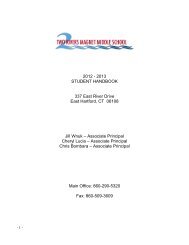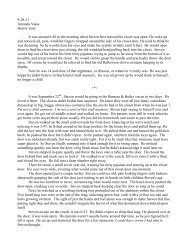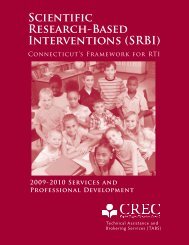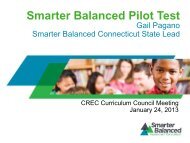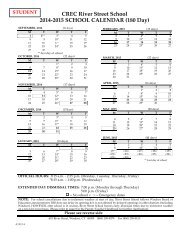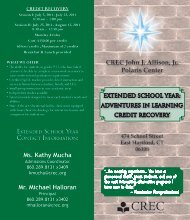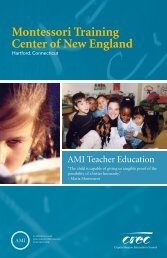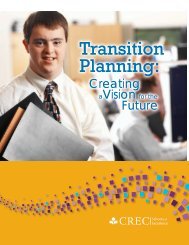Reading and Role Playing: Fiction, Folktales, and Fairy Tale
Reading and Role Playing: Fiction, Folktales, and Fairy Tale
Reading and Role Playing: Fiction, Folktales, and Fairy Tale
Create successful ePaper yourself
Turn your PDF publications into a flip-book with our unique Google optimized e-Paper software.
<strong>Reading</strong> Curricular Calendar, Second Grade, 2012-201312(Margaret Read MacDonald), Mirror Mirror (Marilyn Singer), <strong>and</strong> Spells (Emily Gravett). Wecannot emphasize enough how important it is that children read not only across viewpoints, butacross diverse cultures (<strong>and</strong> of course, the Common Core supports this).As your children think across both age-old tales <strong>and</strong> modern literature, they will probably beginto make allusions unknowingly. An allusion is very similar to a text-to-text connection. Readersmaking a text-to-text connection recognize that something in the book they are reading somehowconnects with a story they know from before. An allusion can be more or less complex. Forexample, when children read Don’t Let the Pigeon Stay Up Late, they will often note that thebunny on the front cover is the same bunny from Knufflebunny, another book written by MoWillems. More significantly, books can allude to other books. For example, The True Story ofthe 3 Little Pigs, by Jon Scieszka, directly alludes to the plot of the original Three Little Pigs.Don’t worry if your kids don’t recognize this on their own (<strong>and</strong> you may or may not decide toteach it).Bend Four – Readers Recognize the Morals, Lessons, <strong>and</strong> Author’s Purpose That Stories ConveyDuring the final bend of this unit, you’ll steer children to think about the lessons authors hopereaders will learn (CCSS RL 2.2). <strong>Fairy</strong> tales <strong>and</strong> folktales also anchor this teaching, becausethey were written to convey morals. You’ll teach children, then, that these tales, like other storiesthey have read, often include a lesson. Readers learn side by side with the characters in thesetales, imagining how we might live our own lives differently because of what we <strong>and</strong> thecharacters have learned. Fables <strong>and</strong> fairy tales offer readers the opportunity to think about lifelessons at the end. After we have identified why characters acted the way they did, we can thinkabout what we can learn from their motives. <strong>Fairy</strong> tales <strong>and</strong> fables are moralistic. They teachyoung readers that greed, jealousy. <strong>and</strong> revenge are wrong. Modern stories your students will bereading, often also convey lessons for young readers. You’ll want to steer your children to noticethese. For example, after reading I Love My New Toy!, by Mo Willems, you might ask, “Whatcan we learn from Piggie, who got so angry at Gerald?” Then say, “When we get angry <strong>and</strong> jumpto conclusions, we may hurt our friends’ feelings. We should not get angry quickly, <strong>and</strong> weshould accept apologies from our friends.” This isn’t so much an opportunity to teach youryoungsters the difference between right <strong>and</strong> wrong as it is a chance to get them to apply whatthey are learning during reading workshop to other contexts. That is, this is another opportunityto steer your students to do DOK Level 4 work.Of course, some tales teach lessons with which we don’t agree. <strong>Reading</strong> them, then, sets childrenup to do some critical thinking. Readers can work in clubs to think about whether a lesson is fair.They can ask themselves, “Do I believe this is a good way to live my life?” or “Was this the bestway to teach the lesson?” One little girl, after reading The Paper Bag Princess, said, “Why isRonald mad at her?” Another girl said, “Because he is a boy. Girls don’t save boys.” Thesestatements <strong>and</strong> conversations can continue the discussion platforms you may have initiatedduring the prior part of the unit. Mostly, you will want to make sure that kids are thinking <strong>and</strong>commenting on one another’s thoughts in honest, genuine ways. You need not push any agenda.Make sure that when you are teaching into these conversations you do so in ways that feelapplicable to kids’ real lives.Unit Six – <strong>Reading</strong> <strong>and</strong> <strong>Role</strong> <strong>Playing</strong>: <strong>Fiction</strong>, <strong>Folktales</strong>, <strong>and</strong> <strong>Fairy</strong> <strong>Tale</strong>s<strong>Reading</strong> <strong>and</strong> Writing Project, 2012 ©DRAFT




